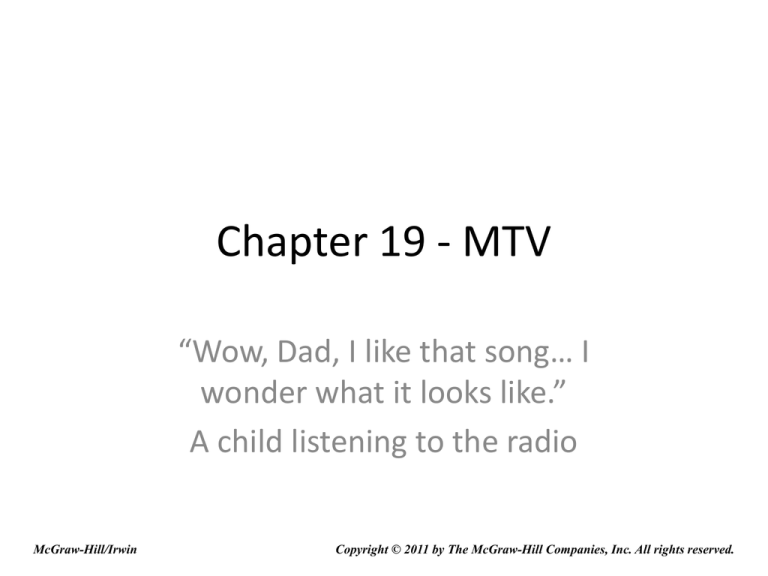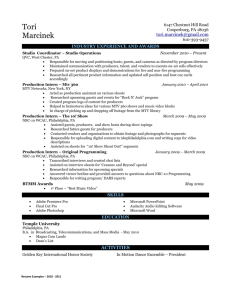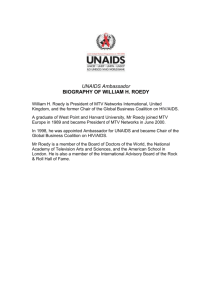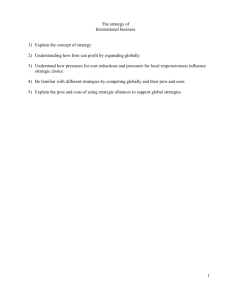
Chapter 19 - MTV
“Wow, Dad, I like that song… I
wonder what it looks like.”
A child listening to the radio
McGraw-Hill/Irwin
Copyright © 2011 by The McGraw-Hill Companies, Inc. All rights reserved.
Cable TV
Late-seventies growth in video technology
Cable TV required cables to be installed under or about streets and physically
connected directly to users homes or businesses
Early video shows:
Album Tracks
Popclips
MTV (Music Television), first aired 1981
Research showed that music supported by videos on MTV increased record sales of
the songs on videos – more videos made to meet the market
Annual MTV Video Music Awards started in 1985, recognize achievement in Music
Video
Early videos by:
Duran Duran
The Stray Cats
Men at Work
Michael Jackson broke racial barrier with Thriller album and video (1982)
MTV videos caused performers’ looks and dancing ability and to be as important as
musicianship, in some cases
19-2
Michael Jackson
(1958-2009)
Motown Record Company child star with the Jackson Five at
age 10
Group left Motown and recorded as the Jacksons
Solo star with Off the Wall album (1979) and four top-10 hit
singles
Called the King of Pop
“Billie Jean” on Thriller album (1983)
Performance on Motown’s 25th Anniversary show in 1983
included the “moon walk” inspired by break dancers’
moves
Success with further albums and performances
Sister, Janet Jackson (born in 1966) also a success on MTV
19-3
Listening Guide
“Billie Jean” by Michael Jackson (1983)
Tempo: 118 beats per minute, 4 beats per bar
Form: 14-bar instrumental introduction, then verses and choruses based on 8
bars, but sometime are extended to 12 bars with repetitions of sections of
text
Features: Strong backbeat in drums
Even beat subdivisions
Synthesized orchestral chords sometimes play on beats 1 and the halfbeat after 2
Other orchestral background includes synthesized strings and horns
Backup vocals support Jackson’s lead vocals through repetitions of text
Lyrics: The song is a cautionary tale about promiscuity, where the singer feels
trapped by the allegation he has fathered a child, even though he does
admit that the baby has his eyes
Charts: Pop, #1 for seven weeks, R&B, #1 for nine weeks, British hits, #1
19-4
Prince
(1958 - ) Son of a jazz musician and a singer, named “Prince” after
Father’s stage name
Grew up playing piano, guitar, and drums
Style combines funk with rock with influences of new wave, disco, and
rap
Reputation for erotic lyrics with Dirty Mind album
“Little Red Corvette” first to-10 single (from 1999) album (1982)
Hired back up band the Revolution for Purple Rain (1984)
Established Paisley Park Records (1985)
Changed his name to an unpronounceable symbol/ “The artist
formerly known as Prince” or “The Artist” in early nineties
Name Prince back in use by early two-thousands
19-5
Listening Guide
“Little Red Corvette” by Prince (1982)
Tempo: 126 beats per minute, 4 beats per bar
Form: 9-bar introduction, then mostly 8-bar sections
Features: Even beat subdivisions, but vocals sometimes uneven
Strong backbeat in drums through much of the recording
Instrumental background is full and features an electronic organ
Prince overdubbed all instrumental parts except the solo guitarist in
instrumental section and Prince sings lead vocals with additional two
backup singers
The recording begins and ends at low volume level with crescendo and
decrescendo in middle
Lyrics: The singer analogizes a promiscuous girl to a red Corvette sports car.
He advises the girl to find monogamy (a love that will last) before her body
fails like a car that is driven too roughly.
Charts: Pop, #6, R&B, #15, British hits, #34
19-6
Madonna
(1958 - ) Born Madonna Louise Ciconne
Madonna’s experience as a modern dancer helped her image on MTV
Performed “Like a Virgin” at the first MTV Music Video Awards (1985)
Other performances at MTV Music Video Awards
“Vogue” (1990)
“Bye Bye Baby” (1993)
“Like a Virgin” and “Hollywood” (2003) with Britney Spears, Christina
Aguilera, and Missy Elliott
Image of an independent woman who did not care about past expectations of
female performers
Sex symbol image in some videos and movie roles
Ranked by the Recording Industry Association of America as the best-selling
female rock artist of the 20th century
19-7
Listening Guide
“Papa Don’t Preach” by Madonna (1986)
Tempo: 126 beats per minute, 4 beats per bar
Form: 16-bar introduction, followed by 8-bar sections, some of which are extended to
10 or 16 bars
Features: Even beat subdivisions
The recording features a synthesized string orchestra in the introduction and as
background later
Drums enter at the 9th bar and play accent a strong backbeat
In addition to drums, rock instruments include electric bass, keyboards, both
acoustic and electric guitars, and other percussion
Backup vocals support Madonna’s lead vocals toward the end of the recording
Lyrics: The singer tells her father that she is pregnant, in love with the baby’s father,
and planning to marry him and keep the baby. She asks her father for advice, but
does not seem to be prepared to accept it.
Charts: Pop, #1 for two weeks, British hits, #1
19-8
Bruce Springsteen
(1949- )
Career began in the seventies, but videos on MTV aided his
worldwide fame during the eighties
Springsteen’s music included:
Rockabilly
Rhythm & blues
Dylanesque folk-rock
Pop style of Phil Spector’s wall of sound
Protopunk sound of garage bands
Songs often geared to American working class and
supported causes to help Vietnam veterans and to
support union workers on strike
19-9
Listening Guide
“Born in the U.S.A.” by Bruce Springsteen (1984)
Tempo: 122 beats per minute, 4 beats per bar
Form: Recording based on repetition of a 2-bar riff. Each 8-bar section
includes the riff played four times.
Features: Uneven beat subdivisions
Strong backbeat in drums
Springsteen’s powerful vocals support the sense of anger in the
lyrics
Lyrics: Sung from the point of view of a Vietnam veteran who returned
to the U.S. having lost his brother in Vietnam, was turned down for
a job, given no assistance from the V.A. Office, and ended up in
prison.
Charts: Pop, #9
19-10
MTV’s Expanded Programming
By the mid-eighties, MTV was criticized for too much pop
programming
Other programs added for MTV2:
120 Minutes featured alternative or underground videos
(1986)
Headbangers Ball with heavy-metal videos and news (1987)
Yo! MTV Raps (1988)
Early nineties, new channel, Dial MTV, for requests
Later years, other channels broadcast rock videos and MTV
expanded to reality shows, awards programs, movies,
political programming, and animated cartoons
19-11
Discussion Questions
Did MTV help provide a vehicle for personal
expression, or was it a means of control?
Did MTV expand diversity and artistic innovation
or narrow them?
19-12







